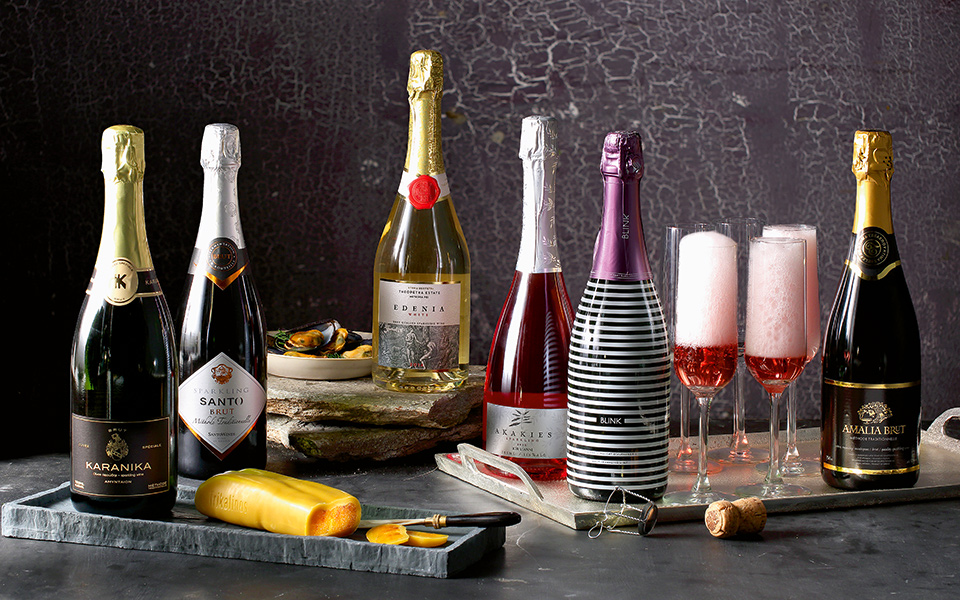A Day in Nemea: Good Wine and Ancient...
Why not try a brief getaway...

Greece, long a producer of sparkling wines, now offers an increasingly rich array of both traditional and newly introduced varieties.
© GEORGE DRAKOPOULOS, STYLING TINA WEBB
Sparkling wines range from very dry to sweet, and from light to rich and fuller-bodied. They can be vintage or non-vintage; they can be whites, reds or rosés. There is, however, one fundamental rule: only those produced in France’s Champagne region can be called champagne – everything else is just sparkling wine.
All sparkling wines have significant levels of carbon dioxide at pressures of between two to six atmospheres, which is responsible for the amount of fizziness. This is achieved during the secondary fermentation process which, in champagnes and wines produced under the “champenoise” or “traditionelle” method, is done in the bottle. The wine is then aged for a significant period of time, sometimes years, and the dead yeast cells, or lees, are removed. (It is the lees that lend an aroma of baked bread or sweet brioche to these wines.)
For the vast majority of other sparkling wines, the secondary fermentation process takes place in a closed stainless steel tank, or cuvee. This ensures the distinctive aromas of flowers and white-fleshed fruits like pears, white peaches and green apples. Transfer is another method, whereby carbon dioxide is added (much like in fizzy soft drinks), while ancestral is yet another process that yields slightly fizzy and sweet wines, and is also responsible for the PET-NAT (Petillant Naturelle, or naturally sparkling) category that will soon make its appearance on Greek shelves.
Greece produced sparkling wines long before regular Greek wine made the qualitative leap that put it on the international map. The main varieties used in the production of sparkling wines are Debina (found in PDO Zitsa wines from Epirus), Xinomavro (PDO Amyntaio, Macedonia), Athiri (PDO Rhodes) and Moschofilero (PDO Mantineia, Peloponnese).
New varieties, such as Muscat of Alexandria, Assyrtiko, Agiorgitiko, Vidiano and Limniona are being introduced to create yet more fashionable and sought-after sparkling wines – with impressive results.
EPIRUS
• The Lefteris Glinavos Brut (made with the traditional method) and the semi-sparkling Debina (with crispy acidity and aromas of pear and green apple), both from Domaine Glinavos.
MACEDONIA
• The Akakies Sparkling and Paranga Sparkling from Ktima Kir-Yianni.
• The exceptionally complex sparkling wines of Domaine Karanikas, all made with the traditional method and responsible for raising the quality bar. Any of the sparkling wines by Apostolos Matamis.
THESSALY
• Tsililis produces a great rosé with Limniona grapes and a white with Malagousia, both sold under the brand name Edenia.
• Blink Zibibbo, made from Muscat of Alexandria by the Pieria Eratini Winery.
PELOPONNESE
The chilly hills of Mantineia yield elegant and aromatic sparkling wines from Moschofilero and Agiorgitiko grapes.
Try the Amalia Brut (white and rosé) from Tselepos and the Ode Panos by Domaine Spiropoulos
CRETE
• Zazazu by Lyrarakis is pleasant and refreshing.
• Sparkling Vidiano by Nikos Douloufakis is made in the traditional method and aged on the lees for 24 months.

© Shutterstock
At least a century ago, winemakers in Zitsa in the highlands of Ioannina in Epirus, western Greece, created, entirely by accident, a sparkling rosé while vinifying a blend of white Debina with red Bekiari and Vlachiko. The bubbles were the result of the area’s chilly and humid climate, which prevented the grapes from fully maturing and prompted the vine-growers to train the vines upward so the grapes could catch as much sunlight as possible.
The grapes did indeed ripen, but their must had such a high sugar content, it did not have time to ferment in September and October before the return of the cold winds from the Pindos Mountains that halted the natural fermentation process. When the warmer weather returned in the springtime, the must contained large quantities of carbon dioxide, which producers gradually learned how to trap in their barrels until the contents were consumed.
Unfortunately, this wine did not travel well and only rarely left the boundaries of Ioannina. Today, however, Zitsa is known for its sparkling and semi-sparkling dry and semi-dry PDO wines, made exclusively with Debina grapes.
The first sparkling wines from Greece to appear on store shelves came from the island of Rhodes, where an Italian investment group founded the Compagnia Agricola Industriale Rodi, whose diverse activities included making both still and sparkling wines.
Local producers soon caught on, so that by the 1960s and 70s, sparkling wines from Rhodes were all the rage, ever-present at all sorts of celebrations across the country. Nowadays, even though the island’s glory days are over, Rhodian vintners continue to produce very decent sparkling wines, in fact with PDO designation.
Why not try a brief getaway...
Discover Greece’s winemaking heritage with tastings,...
The Thessaloniki-born winemaker welcomes us to...
This storied rarity, grown nearly exclusively...